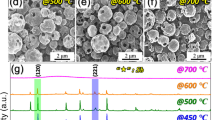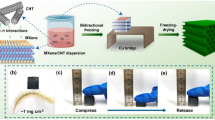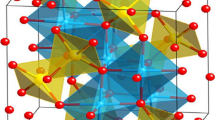Abstract
Flexible supercapacitors (SCs) have become a popular research topic due to their extra-long service life, foldability, and wearability. Nevertheless, their low energy density restricts their applications. Here, we synthesized phosphorus-doped bimetallic sulfides embedded in heteroatom-doped (N, S, and P) carbon shells (P-ZCS/HC) using a simple approach to create high-performance flexible electrodes. The three-dimensional architecture made by interlaced nanosheets was preserved, and raised nanoparticles appeared on the rough surface during the annealing operation, increasing the specific surface area and potential exposure to the electrolyte. It is noteworthy that the optimal P-ZCS/HC electrode possessed a remarkable capacity of 1080 C g−1 at 1 A g−1 along with superb cycling stability. These extraordinary properties were primarily caused by plentiful redox reactions, enhanced conductivity, and synergic effects of the P-doped metal sulfides and heteroatom-doped carbon shells. Density functional theory simulations confirmed the good function of the P-doped electrodes and their ability to boost conductivity, improve reactive dynamics, and promote OH− adsorption. Notably, the assembled all-solid-state hybrid SC exhibited a maximum energy density of 62.9 W h kg−1 and a power density of 16 kW kg−1, while being able to maintain 92.0% of its initial capacity after 10,000 cycles. This systematic report provides new insight into the design and synthesis of electrodes with complex components and outstanding structures for the flexible energy field.

摘要
柔性超级电容器具有超长使用寿命、可折叠、可穿戴等特点, 已成为研究热点. 然而, 较低的能量密度限制了其更广泛的应用. 本文采用简单的方法合成了一种嵌入多原子(氮, 硫和磷原子)掺杂碳壳的磷掺杂双金属硫化物(P-ZCS/HC)作为高性能柔性电极. 在退火过程中, 前驱体的三维形貌保持不变, 同时纳米片表面有凸起的纳米球形颗粒形成, 这大大增加了电极的比表面积. 优化后的P-ZCS/HC电极在1 A g−1时具有1080 C g−1高比电容值, 且循环稳定性出色. 这些优异的性能主要是由于该电极材料可发生丰富的氧化还原反应, 磷化后增强的导电性, 以及磷掺杂金属硫化物和多原子掺杂碳壳之间的协同效应. 密度泛函理论模拟表明, 磷掺杂处理具有提高电导率、改善反应动力学和促进OH−吸附的积极作用.组装的全固态柔性混合超级电容器最高能量密度可达62.9 W h kg−1, 功率密度可达16 kW kg−1, 循环10,000次后仍能保持初始容量的92.0%. 这一完整和系统的研究为将来设计具有复杂成分和优异结构的柔性电极提供了一种新的思路.
Similar content being viewed by others
References
Liu W, Song MS, Kong B, et al. Flexible and stretchable energy storage: Recent advances and future perspectives. Adv Mater, 2017, 29: 1603436
Lv T, Liu M, Zhu D, et al. Nanocarbon-based materials for flexible all-solid-state supercapacitors. Adv Mater, 2018, 30: 1705489
Yao B, Zhang J, Kou T, et al. Paper-based electrodes for flexible energy storage devices. Adv Sci, 2017, 4: 1700107
Kumar KS, Choudhary N, Jung Y, et al. Recent advances in two-dimensional nanomaterials for supercapacitor electrode applications. ACS Energy Lett, 2018, 3: 482–495
Qu G, Cheng J, Li X, et al. A fiber supercapacitor with high energy density based on hollow graphene/conducting polymer fiber electrode. Adv Mater, 2016, 28: 3646–3652
Yu J, Lu W, Smith JP, et al. A high performance stretchable asymmetric fiber-shaped supercapacitor with a core-sheath helical structure. Adv Energy Mater, 2017, 7: 1600976
Zhao Y, He X, Chen R, et al. A flexible all-solid-state asymmetric supercapacitors based on hierarchical carbon cloth@CoMoO4@NiCo layered double hydroxide core-shell heterostructures. Chem Eng J, 2018, 352: 29–38
He X, Zhao Y, Chen R, et al. Hierarchical FeCo2O4@polypyrrole core/shell nanowires on carbon cloth for high-performance flexible all-solid-state asymmetric supercapacitors. ACS Sustain Chem Eng, 2018, 6: 14945–14954
Xu W, Jiang Z, Yang Q, et al. Approaching the lithium-manganese oxides’ energy storage limit with Li2MnO3 nanorods for highperformance supercapacitor. Nano Energy, 2018, 43: 168–176
Chen L, Chen L, Zhai W, et al. Tunable synthesis of LixMnO2 nanowires for aqueous Li-ion hybrid supercapacitor with high rate capability and ultra-long cycle life. J Power Sources, 2019, 413: 302–309
Zhang Y, Chen L, Hao C, et al. Potassium pre-inserted K1.04Mn8O16 as cathode materials for aqueous Li-ion and Na-ion hybrid capacitors. J Energy Chem, 2020, 46: 53–61
Yang Y, Huang W, Li S, et al. Surfactant-dependent flower- and grass-like Zn0.76Co0.24S/Co3S4 for high-performance all-solid-state asymmetric supercapacitors. J Mater Chem A, 2018, 6: 22830–22839
Li S, Huang W, Yang Y, et al. Hierarchical layer-by-layer porous FeCo2S4@Ni(OH)2 arrays for all-solid-state asymmetric supercapacitors. J Mater Chem A, 2018, 6: 20480–20490
Yang J, Yu C, Fan X, et al. Electroactive edge site-enriched nickel-cobalt sulfide into graphene frameworks for high-performance asymmetric supercapacitors. Energy Environ Sci, 2016, 9: 1299–1307
Zhou J, Wang L, Yang M, et al. Hierarchical VS2 nanosheet assemblies: A universal host material for the reversible storage of alkali metal ions. Adv Mater, 2017, 29: 1702061
Li J, Liu Z, Zhang Q, et al. Anion and cation substitution in transition-metal oxides nanosheets for high-performance hybrid supercapacitors. Nano Energy, 2019, 57: 22–33
He G, Qiao M, Li W, et al. S,N-co-doped graphene-nickel cobalt sulfide aerogel: Improved energy storage and electrocatalytic performance Adv Sci, 2017, 4: 1600214
He W, Ifraemov R, Raslin A, et al. Room-temperature electrochemical conversion of metal-organic frameworks into porous amorphous metal sulfides with tailored composition and hydrogen evolution activity. Adv Funct Mater, 2018, 28: 1707244
Dai Z, Geng H, Wang J, et al. Hexagonal-phase cobalt mono-phosphosulfide for highly efficient overall water splitting. ACS Nano, 2017, 11: 11031–11040
Liu W, Hu E, Jiang H, et al. A highly active and stable hydrogen evolution catalyst based on pyrite-structured cobalt phosphosulfide. Nat Commun, 2016, 7: 10771
Ye R, del Angel-Vicente P, Liu Y, et al. High-performance hydrogen evolution from MoS2(1−x)Px solid solution. Adv Mater, 2016, 28: 1427–1432
Lin J, Wang Y, Zheng X, et al. P-doped NiCo2S4 nanotubes as battery-type electrodes for high-performance asymmetric supercapacitors. Dalton Trans, 2018, 47: 8771–8778
Kong D, Wang Y, Huang S, et al. 3D self-branched zinc-cobalt oxide@N-doped carbon hollow nanowall arrays for high-performance asymmetric supercapacitors and oxygen electrocatalysis. Energy Storage Mater, 2019, 23: 653–663
Guan C, Liu X, Ren W, et al. Rational design of metal-organic framework derived hollow NiCo2O4 arrays for flexible supercapacitor and electrocatalysis. Adv Energy Mater, 2017, 7: 1602391
Guan C, Xiao W, Wu H, et al. Hollow Mo-doped CoP nanoarrays for efficient overall water splitting. Nano Energy, 2018, 48: 73–80
He W, Wang C, Li H, et al. Ultrathin and porous Ni3S2/CoNi2S4 3D-network structure for superhigh energy density asymmetric supercapacitors. Adv Energy Mater, 2017, 7: 1700983
He D, Xing S, Sun B, et al. Design and construction of three-dimensional flower-like CuO hierarchical nanostructures on copper foam for high performance supercapacitor. Electrochim Acta, 2016, 210: 639–645
Barai HR, Rahman MM, Joo SW. Annealing-free synthesis of K-doped mixed-phase TiO2 nanofibers on Ti foil for electrochemical supercapacitor. Electrochim Acta, 2017, 253: 563–571
Chen HC, Jiang S, Xu B, et al. Sea-urchin-like nickel-cobalt phosphide/phosphate composites as advanced battery materials for hybrid supercapacitors. J Mater Chem A, 2019, 7: 6241–6249
Zhu J, Tang S, Wu J, et al. Wearable high-performance supercapacitors based on silver-sputtered textiles with FeCo2S4-NiCo2S4 composite nanotube-built multitripod architectures as advanced flexible electrodes. Adv Energy Mater, 2017, 7: 1601234
Li S, Hua M, Yang Y, et al. Self-supported multidimensional Ni-Fe phosphide networks with holey nanosheets for high-performance all-solid-state supercapacitors. J Mater Chem A, 2019, 7: 17386–17399
Kresse G, Furthmüller J. Efficient iterative schemes for ab initio total-energy calculations using a plane-wave basis set. Phys Rev B, 1996, 54: 11169–11186
Blöchl PE. Projector augmented-wave method. Phys Rev B, 1994, 50: 17953–17979
Peng S, Li L, Wu HB, et al. Controlled growth of NiMoO4 nanosheet and nanorod arrays on various conductive substrates as advanced electrodes for asymmetric supercapacitors. Adv Energy Mater, 2015, 5: 1401172
Sun W, Du Y, Wu G, et al. Constructing metallic zinc-cobalt sulfide hierarchical core-shell nanosheet arrays derived from 2D metal-organic-frameworks for flexible asymmetric supercapacitors with ultrahigh specific capacitance and performance. J Mater Chem A, 2019, 7: 7138–7150
Shangguan H, Huang W, Engelbrekt C, et al. Well-defined cobalt sulfide nanoparticles locked in 3D hollow nitrogen-doped carbon shells for superior lithium and sodium storage. Energy Storage Mater, 2019, 18: 114–124
Yang Y, Li S, Huang W, et al. Effective synthetic strategy for Zn0.76Co0.24S encapsulated in stabilized N-doped carbon nanoarchitecture towards ultra-long-life hybrid supercapacitors. J Mater Chem A, 2019, 7: 14670–14680
Zhang H, Wang T, Sumboja A, et al. Integrated hierarchical carbon flake arrays with hollow P-doped CoSe2 nanoclusters as an advanced bifunctional catalyst for Zn-air batteries. Adv Funct Mater, 2018, 28: 1804846
Guan C, Sumboja A, Wu H, et al. Hollow Co3O4 nanosphere embedded in carbon arrays for stable and flexible solid-state zinc-air batteries. Adv Mater, 2017, 29: 1704117
Ouyang C, Wang X, Wang S. Phosphorus-doped CoS2 nanosheet arrays as ultra-efficient electrocatalysts for the hydrogen evolution reaction. Chem Commun, 2015, 51: 14160–14163
Xu X, Liu Y, Wang M, et al. Hierarchical hybrids with micro-porous carbon spheres decorated three-dimensional graphene frameworks for capacitive applications in supercapacitor and deionization. Electrochim Acta, 2016, 193: 88–95
Liang Z, Yang Z, Dang J, et al. Hollow bimetallic zinc cobalt phosphosulfides for efficient overall water splitting. Chem Eur J, 2018, 25: chem.201804492
Li S, Yang N, Liao L, et al. Doping β-CoMoO4 nanoplates with phosphorus for efficient hydrogen evolution reaction in alkaline media. ACS Appl Mater Interfaces, 2018, 10: 37038–37045
Sun J, Ren M, Yu L, et al. Highly efficient hydrogen evolution from a mesoporous hybrid of nickel phosphide nanoparticles anchored on cobalt phosphosulfide/phosphide nanosheet arrays. Small, 2019, 15: 1804272
Elshahawy AM, Guan C, Li X, et al. Sulfur-doped cobalt phosphide nanotube arrays for highly stable hybrid supercapacitor. Nano Energy, 2017, 39: 162–171
Yin X, Sun W, Lv LP, et al. Boosting lithium-ion storage performance by synergistically coupling Zn0.76Co0.24S with N-/S-doped carbon and carbon nanofiber. Chem Eng J, 2018, 346: 376–387
Yu Z, Bai Y, Zhang S, et al. Metal-organic framework-derived Zn0.975Co0.025S/CoS2 embedded in N,S-codoped carbon nanotube/nanopolyhedra as an efficient electrocatalyst for overall water splitting. J Mater Chem A, 2018, 6: 10441–10446
Lu Q, Zou X, Ran R, et al. An “electronegative” bifunctional coating layer: Simultaneous regulation of polysulfide and Li-ion adsorption sites for long-cycling and “dendrite-free” Li-S batteries. J Mater Chem A, 2019, 7: 22463–22474
Wang M, Zhang C, Meng T, et al. Iron oxide and phosphide encapsulated within N,P-doped microporous carbon nanofibers as advanced tri-functional electrocatalyst toward oxygen reduction/evolution and hydrogen evolution reactions and zinc-air batteries. J Power Sources, 2019, 413: 367–375
Zheng X, Wu J, Cao X, et al. N-, P-, and S-doped graphene-like carbon catalysts derived from onium salts with enhanced oxygen chemisorption for Zn-air battery cathodes. Appl Catal B-Environ, 2019, 241: 442–451
Zhou X, Liao X, Pan X, et al. Unveiling the role of surface P-O group in P-doped Co3O4 for electrocatalytic oxygen evolution by on-chip micro-device Nano Energy, 2021, 83: 105748
Wang Z, Liu H, Ge R, et al. Phosphorus-doped Co3O4 nanowire array: A highly efficient bifunctional electrocatalyst for overall water splitting. ACS Catal, 2018, 8: 2236–2241
Gao J, Jiang B, Ni C, et al. Enhanced reduction of nitrate by noble metal-free electrocatalysis on P doped three-dimensional Co3O4 cathode: Mechanism exploration from both experimental and DFT studies Chem Eng J, 2020, 382: 123034
Long X, Li G, Wang Z, et al. Metallic iron-nickel sulfide ultrathin nanosheets as a highly active electrocatalyst for hydrogen evolution reaction in acidic media. J Am Chem Soc, 2015, 137: 11900–11903
Zheng F, Yang Y, Chen Q. High lithium anodic performance of highly nitrogen-doped porous carbon prepared from a metal-organic framework Nat Commun, 2014, 5: 5261
Lu Q, Yu J, Zou X, et al. Self-catalyzed growth of Co,N-codoped CNTs on carbon-encased CoSx surface: A noble-metal-free bifunctional oxygen electrocatalyst for flexible solid Zn-air batteries. Adv Funct Mater, 2019, 29: 1904481
Chen L, Yang W, Li X, et al. Co9S8 embedded into N/S doped carbon composites: In situ derivation from a sulfonate-based metal-organic framework and its electrochemical properties. J Mater Chem A, 2019, 7: 10331–10337
Yang Q, Liu Y, Xiao L, et al. Self-templated transformation of MOFs into layered double hydroxide nanoarrays with selectively formed Co9S8 for high-performance asymmetric supercapacitors Chem Eng J, 2018, 354: 716–726
Liu W, Niu H, Yang J, et al. Ternary transition metal sulfides embedded in graphene nanosheets as both the anode and cathode for high-performance asymmetric supercapacitors Chem Mater, 2018, 30: 1055–1068
Jia H, Wang Z, Zheng X, et al. Controlled synthesis of MOF-derived quadruple-shelled CoS2 hollow dodecahedrons as enhanced electrodes for supercapacitors. Electrochim Acta, 2019, 312: 54–61
Jiang D, Liang H, Yang W, et al. Screen-printable films of graphene/CoS2/Ni3S4 composites for the fabrication of flexible and arbitrary-shaped all-solid-state hybrid supercapacitors. Carbon, 2019, 146: 557–567
Pan Q, Liu Y, Zhao L Co9S8/Mo2S3 nanorods on CoS2 laminar arrays as advanced electrode with superior rate properties and long cycle life for asymmetric supercapacitors. Chem Eng J, 2018, 351: 603–612
Yan J, Ren CE, Maleski K, et al. Flexible MXene/graphene films for ultrafast supercapacitors with outstanding volumetric capacitance Adv Funct Mater, 2017, 27: 1701264
Hu X, Liu X, Chen K, et al. Core-shell MOF-derived N-doped yolk-shell carbon nanocages homogenously filled with ZnSe and CoSe2 nanodots as excellent anode materials for lithium- and sodium-ion batteries. J Mater Chem A, 2019, 7: 11016–11037
Zong Q, Yang H, Wang Q, et al. NiCo2O4/NiCoP nanoflake-nanowire arrays: A homogeneous hetero-structure for high performance asymmetric hybrid supercapacitors. Dalton Trans, 2018, 47: 16320–16328
Lan Y, Zhao H, Zong Y, et al. Phosphorization boosts the capacitance of mixed metal nanosheet arrays for high performance supercapacitor electrodes Nanoscale, 2018, 10: 11775–11781
Liu J, Wang J, Xu C, et al. Advanced energy storage devices: Basic principles, analytical methods, and rational materials design. Adv Sci, 2018, 5: 1700322
Nguyen TT, Balamurugan J, Kim NH, et al. Hierarchical 3D Zn-Ni-P nanosheet arrays as an advanced electrode for high-performance all-solid-state asymmetric supercapacitors. J Mater Chem A, 2018, 6: 8669–8681
Qu C, Zhang L, Meng W, et al. MOF-derived a-NiS nanorods on graphene as an electrode for high-energy-density supercapacitors. J Mater Chem A, 2018, 6: 4003–4012
Zhang Q, Liu Z, Zhao B, et al. Design and understanding of dendritic mixed-metal hydroxide nanosheets@N-doped carbon nanotube array electrode for high-performance asymmetric supercapacitors. Energy Storage Mater, 2019, 16: 632–645
Lin J, Zhong Z, Wang H, et al. Rational constructing free-standing Se doped nickel-cobalt sulfides nanotubes as battery-type electrode for high-performance supercapattery. J Power Sources, 2018, 407: 6–13
Chen X, Cheng M, Chen D, et al. Shape-controlled synthesis of Co2P nanostructures and their application in supercapacitors. ACS Appl Mater Interfaces, 2016, 8: 3892–3900
Shen L, Wang J, Xu G, et al. NiCo2S4 nanosheets grown on nitrogen-doped carbon foams as an advanced electrode for supercapacitors. Adv Energy Mater, 2015, 5: 1400977
Acknowledgements
This work was supported by research projects from the Department of Science and Technology of Shandong Province (2018JMRH0211, ZR2019MEM052, 2019TSLH0101 and ZR2018ZB0105), and the Fundamental Research Funds of Shandong University (2017JC042 and 2017JC010). Jun Lou was supported by a Welch Foundation grant (C-1716).
Author information
Authors and Affiliations
Contributions
Li S and Si P designed the project and wrote the paper; Li S carried out most of the experiments; Hua M performed the DFT simulations; Yang Y helped with the data processing; Zheng X conducted the Raman tests; Huang W conducted the TEM and XPS measurements; Si P, Ci L and Lou J provided constructive suggestions. All authors contributed to the general discussion.
Corresponding author
Additional information
Conflict of interest
The authors declare that they have no conflict of interest.
Shuo Li obtained her Bachelor degree in 2016 from the School of Materials Science and Engineering, Shandong University. She is currently a PhD student under the supervision of Prof. Pengchao Si at Shandong University. Her present research interests mostly concentrate on the transition metal sulfides and phosphides for energy storage applications.
Pengchao Si received his PhD degree in 2007 in natural science from Roskilde University, Denmark. Then he worked as a postdoctoral research fellow in the Department of Chemistry, Curtin University. He has been a full professor at the School of Materials Science and Engineering, Shandong University since 2010. His present research interests are mainly on the synthesis of nanomaterials for energy storage, conversion and electrochemical sensors.
Supplementary information
40843_2020_1667_MOESM1_ESM.pdf
Phosphorous-doped bimetallic sulfides embedded in heteroatom-doped carbon nanoarrays for flexible all-solid-state supercapacitors
Rights and permissions
About this article
Cite this article
Li, S., Hua, M., Yang, Y. et al. Phosphorous-doped bimetallic sulfides embedded in heteroatom-doped carbon nanoarrays for flexible all-solid-state supercapacitors. Sci. China Mater. 64, 2439–2453 (2021). https://doi.org/10.1007/s40843-020-1667-1
Received:
Accepted:
Published:
Issue Date:
DOI: https://doi.org/10.1007/s40843-020-1667-1




